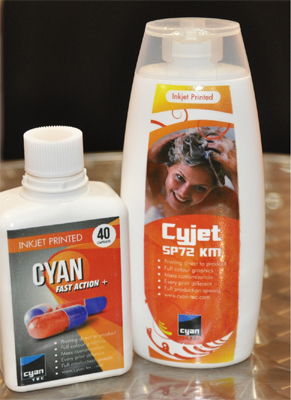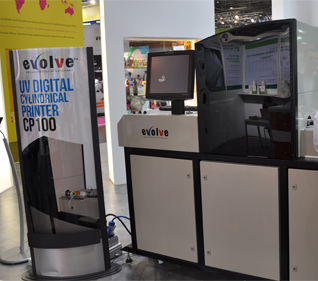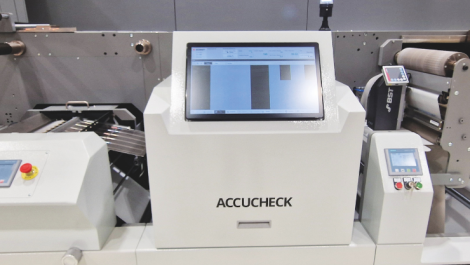The no-label look is very popular with many brands choosing clear film substrates, but technology is progressing to print directly on a pack and remove the label itself. This promises greater flexibility at the packer/filler, and while there is some way to go, new equipment on show at Drink Tec in September, shows promise. BySean Smyth.
Non-impact inkjet printing has been used on packing and filling lines to apply batch and best before information for many years. As the reliability and quality of the printing improves, there are developments to add full colour print capability into these systems.
Offerings
In June, Cambridge based supplier of Konica Minolta printheads and systems, Industrial Inkjet, hosted a seminar focusing on the advantages of direct pack printing, reflecting increasing interest in the topic from prospective equipment manufacturers.
IIJ has much experience of direct to pack printing with its customers selling turnkey machines and making bespoke equipment that integrates into converting equipment. One customer is French integrator SMT Digital, in Oyonnax, which supplies glass decorating systems using UV curing inkjet. It produced some development bottles for a limited edition Stella McCartney perfume, these took off and the integrator used its own solution to produce significant volumes.
Leicester-based Cyan Tec is another integrator who is using IIJ components. The Cyan Tec Group is selling specialist inkjet printing systems, with the CyJet SP72, a process colour print unit, with optional white that is combined with a material transport system. It is designed to apply full colour graphics to a range of products, including direct printing onto packaging and industrial applications.
Cyan Tec will supply optional vision alignment and image checking systems, manually loaded product station and robot in/out automated loading system or a modular pallet transport systems. It will provide bespoke jig and fixture design and production services to deliver a full production system.
Other services offered include final spray finishing stations, automated product assembly stations on either side of the printer, glue dispensers, laser marking and cutting, web systems and so forth. Managing director, Clayton Sampson, said they had sold four systems for very different applications. One is to a UK based blue-chip pharmaceutical manufacturer which is printing high quality colour logos and information onto blister foils.
On the bottle
Screen printing has been used to print glass bottles for many years and there are sophisticated machines that load, print, dry and deliver high volumes of bottles. Digital is increasingly used with non-impact inkjet – and Tonejet for metal cans – increasingly being used. Machines Dubuit is a speciality French equipment and ink supplier, selling automatic and semi-automatic screen printers for bottles, jars, drinking vessels, caps and rigid plastics, up to nine colours. In partnership with its sister company, Encres Dubuit, it has launched the 992 machine, that prints onto plastic tubes in four colour inkjet, with surface treatment and drying.
INX Digital, part of the giant Sakata ink company, has a range of innovative inkjet systems. It supplies print engines and printers as standalone products, or for customisation and integration into existing print and conversion lines. The CP100 is a cylinder printer, with bottles, tubes and cans among the applications.
It features Xaar printheads in four to eight colour options, offering white and clear ink capability. The machine is a mandrel design that rotates the cylindrical object in front of the inkjet heads and LED curing station. It is quite slow, between two to five objects per minute, slower at the highest resolution.
At the upcoming Drink Tec show in Munich, the German filling equipment manufacturer KHS will show the new Innoprint machine that print directly onto PET bottles, eliminating the need for labels. One target application would be to allow global beverage companies to print onto bottles at precisely the same time across selected markets.
The system uses UV inks at optical resolution of 1,080 pixels (suggesting it uses Konica Minolta heads). This new machine is capable of processing a great variety of PET bottle types ranging in size from 0.33 to 1.5 litres. Container diameters can vary between 40 mm and 120 mm and the machine is designed for a capacity of 36,000 PET bottles per hour.
While there are few details in the public domain, a patent search shows several patents assigned to KHS dating back to 2007 describing systems with inkjet heads for printing bottles and containers moved along a transport path.
Also at the Drink Tec is Till Engineering showing its direct to bottle printer, the Smart Print Machines. The system is modular with a capacity of up to 800 containers per hour and in up to eight colours from each module. Multiple stations can be combined to yield higher output.
Till has years of experience in the beverage filling and has designed the Smart Machines for high performance operations, while it can be used for test patterns and prints. It showed samples at last year’s Smithers Pira Digital Packaging conference on bottles and cans. Image quality was not up to the highest demands of brand owners yet, but much work is being done to improve quality.
 The Cyan Tec Group is selling specialist inkjet printing systems, with the CyJet SP72, a process colour print unit, with optional white that is combined with a material transport system
The Cyan Tec Group is selling specialist inkjet printing systems, with the CyJet SP72, a process colour print unit, with optional white that is combined with a material transport system
Issues to consider
When using inkjet to print an irregular shaped object, there are several issues for a system supplier to consider. The first is the variable throw distance between the inkjet head and the printed surface, then the impact on quality of differences in ink lay and hence quality in printing lips and ridges. The larger the drop, the further the potential throw distance that might be up to 5 mm for drops of 42 pl (picolitres).
Using these large drops gives a compromise on quality, however, but with smaller ink drops the impact of air turbulence limits the consistency and quality. As the object to be printed has to be presented to the print heads, that may be fixed or they may move, there may be air turbulence at high speed to be overcome.
The other issue is ink lay and adhesion to the range of materials to be printed, and the impact of overprinting several colours, with white. The secret in successful applications is having a stable transport method of using clean, dry items that may be pre-treated with flame, plasma or corona treatment to improve the ink receptivity of the surface. The curing mechanism is also important, allowing the right balance between ink spreading and promoting adhesion.
No labels
Eliminating labels offers the advantage of not having to buy them and incur downtime on filling and bottling lines when a label change is necessary. This does not only occur when there is a change in the pack or its contents, many products require versions of labels for different countries and regions, and lines are stopped while the label is changed.
There may be application problems, but label converters are well versed in the tension and presentation requirements of their customers. There will typically be wastage, running out of a label is more costly than ordering overs which become redundant. Against these benefits a high quality print system will be costly, and will require skilled operators to make it works properly and produces consistent high quality.
Applying physical labels can present challenges and direct printing of them is likely to be more complicated. There are potential supply chain benefits, and in pharmaceutical packaging printing onto blisters, labels and cartons is growing as late-stage customisation proves beneficial.
The concept of direct printing is not new; eliminating labels and sleeves may be advantageous logistically. The proponents of the technology are pushing again as inkjet technology has improved, claiming this enables service providers to move from product oriented production to customer oriented production.
As more installations are commissioned, we will see further convergence of the coding and marking sector with high quality graphics printing, with advantages for the fillers and packers to provide more value.
Further developments are necessary, and these are being explored as new approaches to packaging and labelling are being shown as concepts. There is a great deal of interest and there will be more systems being offered to the market.
The costs and marketing benefits of direct printing are changing, and this provides an opportunity for a different part of the chain to grab more of the overall value share. So in future, the no-label look may well be there being no separate label!






